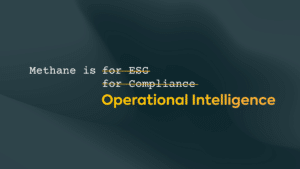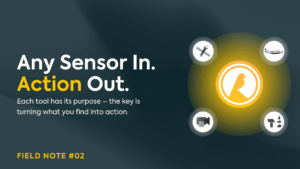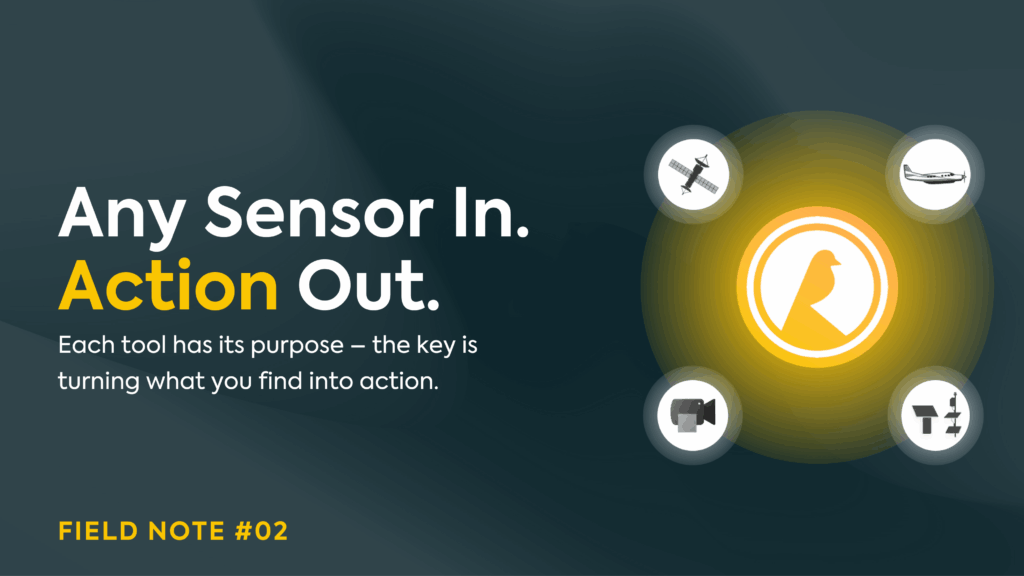By Will Foiles
The question I hear most is, “Which is better for methane monitoring, satellites, aerial, or ground sensors?” That is the wrong debate. These tools solve different problems. Satellites provide wide-area snapshots and capture large events but offer little to no information on when they occurred or how long they lasted. Fixed measurements reveal emissions around the clock at a specific facility, providing no insight into what occurred at other facilities. The key to success is using what fits the situation, bringing all of it together, and turning it into clear next steps.
What each tool is good at
- Satellites: Offer extensive coverage, snapshot in time, ideal for major episodic releases and basin-scale screening.
- Aerial: Provides extensive coverage, a snapshot at a specific moment, effective for both small and large emissions, and sometimes used for basin-wide screening.
- Fixed sensors: Continuous signals at the site, useful for detecting leaks quickly and enabling the identification of patterns or small conditional shifts by linking them with operational data
- Mobile surveys (vehicle or handheld): Flexible, go wherever the signal is, and are useful for troubleshooting, confirming a fix, meeting regulatory requirements, and, in the case of handheld devices, measuring source-level operational emissions at specific points in time.
Bring signals together, then get to the “so what?”
Measurement is just the beginning. The real progress comes from shifting from measurement to operational intelligence, the “so what” that clarifies what is happening and what should happen next. The first step is understanding which technology to utilize for coverage of a wide range of assets. This enables operators to deploy more robust measurements, be it more frequent snapshots or continuous ground-based measurements, on the facilities where it makes sense. The next step involves combining sensor signals with existing operational data: workovers, tank pickups, equipment condition, and activity. When executed correctly, a plume becomes a meaningful signal instead of a mystery.
Close the loop so results are real
After you detect something, follow a coordinated workflow. Typically, this involves service contractors. Keep the chain of custody clear so you know who did what and when. Return later to re-measure and demonstrate the change. Use the same data flows to generate trustworthy reports. How this looks in the field
- A field-level employee receives a push notification on the mobile app that a non-profit satellite detected a significant event three days ago, which the algorithm has tied to your facilities.
- Upon reviewing the facility’s data, the employee notices the “Activity Log”, which is automatically synchronized with the mobile app and the event in question, showing a liquids unloading event occurred at the facility on the day in question.
- The field-level employee determines that this satellite observation is likely not an ongoing emissions event based on the Activity Log and therefore schedules a low-priority mobile survey to occur within the next week for confirmation.
- A member of the leak detection and repair (LDAR) team notices the added mobile survey the next day, and since they will happen to be in the area that afternoon, plans to stop by the facility to perform a mobile survey.
- As the field-level employee thought, the LDAR team member found no leak. The information is recorded in the mobile app.
- A member of the EHS team automatically receives an email notification about LDAR observations, ensuring they are prepared if a senior executive inquires when the event is made public by a non-profit organization.
- Information about the event, including its cause, duration, and total emissions, is automatically shared with the nonprofit, ensuring that when the event is published to the nonprofit’s website, it clearly states that it was not an unintended leak, reducing the risk that an inquiry is made by external parties.
- Data related to the event, including the follow-up by the LDAR team, is also shared with the company’s regulatory emissions reporting platform to prevent double-counting for both regulatory and voluntary emissions initiatives.
Final thought:
The future is not about chasing the right sensor. It is about transforming every signal into trusted intelligence that drives decisions, closes the loop, and proves results. When measurement becomes action and action becomes verified performance, emissions management shifts from a regulatory and compliance obligation into an operational advantage. The operators who close the loop in this way will not only keep pace with expectations, they will set the standard for industry leadership.


